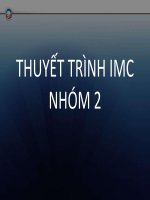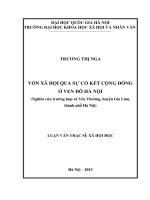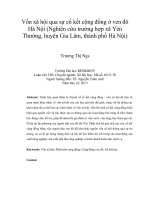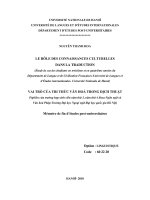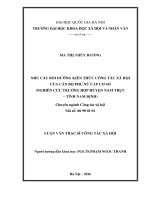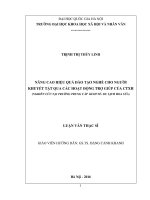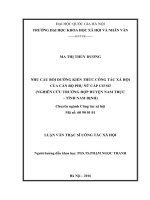Kiến tạo bản sắc thông qua diễn ngôn của một ứng cử viên tổng thống một nghiên cứu trường hợp cụ thể
Bạn đang xem bản rút gọn của tài liệu. Xem và tải ngay bản đầy đủ của tài liệu tại đây (1.78 MB, 143 trang )
VIETNAM NATIONAL UNIVERSITY OF HANOI
THE UNIVERSITY OF LANGUAGES AND INTERNATIONAL STUDIES
FACULTY OF GRADUATE STUDIES
MAI VĂN KẾT
THE DISCURSIVE CONSTRUCTION OF IDENTITY OF
A PRESIDENTIAL CANDIDATE: A CASE STUDY
(KIẾN TẠO BẢN SẮC THÔNG QUA DIỄN NGÔN
CỦA MỘT ỨNG CỬ VIÊN TỔNG THỐNG:MỘT NGHIÊN CỨU
TRƯỜNG HỢP CỤ THỂ)
Major master thesis
Major: English linguistics
Code: 60220201
HANOI - 2017
VIETNAM NATIONAL UNIVERSITY OF HANOI
THE UNIVERSITY OF LANGUAGES AND INTERNATIONAL STUDIES
FACULTY OF RADUATE STUDIES
MAI VĂN KẾT
THE DISCURSIVE CONSTRUCTION OF IDENTITY OF
A PRESIDENTIAL CANDIDATE: A CASE STUDY
(KIẾN TẠO BẢN SẮC THÔNG QUA DIỄN NGÔN
CỦA MỘT ỨNG CỬ VIÊN TỔNG THỐNG:MỘT NGHIÊN CỨU
TRƯỜNG HỢP CỤ THỂ)
Major master thesis
Major: English linguistics
Code: 60220201
Supervisor: Professor Nguyễn Hoà
HANOI - 2017
DECLARATION OF AUTHORSHIP
I hereby state that I, Mai Van Ket, a student of the Faculty of Graduate
Studies, University of Languages and International Studies, Vietnam National
University, Hanoi, certify with my signature that my thesis entitled „The Discursive
Construction of Identity of a Presidential Candidate: A Case Study‟ is entirely the
result of my own work. I have faithfully and accurately cited all my sources,
including books, journals, newspaper articles, generics, doctoral dissertations, and
online resources. I declare that I understood the concept of plagiarism and I
acknowledge that my thesis will be rejected in case of plagiarism.
The thesis contains no materials that has been submitted previously, in whole or in
part, for the award of any other academic degree or diploma.
Supervisor‟s signature
Student‟s signature
GS. NguyễnHoà
Mai VănKết
i
ACKNOWLEDGEMENTS
I would like to thank my thesis supervisor Professor Nguyen Hoa at
University of Languages and International Studies, Vietnam National
University, Hanoi for his thoughtful andfruitful series of lectureson discourse
analysis, which led and shed light to this present study. I gratefully owed him
the introduction to Hillary Clinton and the speech, to the issue of identity in
sociolinguistics. Especially, I wish to thank him for his constant guidance,
dedication and professionalism which helped me to complete the final report
of this study project.
My sincere gratitudes go to the lecturers at the Faculty of Postgraduate
Studies, University of Languages and International Studies, Vietnam National
University, Hanoi for their interesting lectures, suggestions and scientific
research, which inspired me to go in the journey of academics. I cannot
express enough thanksto Doctor Huynh Anh Tuan, Dean ofthe Faculty of
Graduate Studies,for providing me with an opportunity to do the project work
and providing me with such a nice support and encourgagement, although he
had busy schedule managing the corporate affairs.
Last but not least, I must express my very profound gratitudes to my
family and friends for providng me with unfailing support and comfort
throughout my years of study.
Thank you!
ii
ABSTRACT
In the last decades, the focus on identity in social sciences has increased
enormously. Identity construction appears to be practices that sometimes
escape our attention in teaching practices but they exert an enormous
influence on education. Though much research has been undertaken on
identity, there exist gaps that need further theoretical and practical
advancements. Most importantly, a critical review suggests that there is an
absence of identity research in Vietnam. In order to address such gaps, the
present thesis explores the discursive construction of identity ina presidential
campaign speech. This study employs critical discourse analysis as an
interdisciplinary approach to reality and representation of social actors and
language styles are synthesized as an analytical framework. The study takes a
special interest in the way Hillary Clinton discursively projects and negotiates
identity to communicate in her campaign in a discursive process. The key
findings of the study indicate that collective and personal identity was
discursively constructed in the strategic choice of language. The results of the
study contribute to an understanding of identity construction in political
campaign discourses. Practical suggestions
for successful language
communication and further research were also identified.
Keywords:personal identity, collective identity, critical discourse
analysis, discursive, interconnectedness, social actors, weapon
iii
TABLE OF CONTENTS
DECLARATION OF AUTHORSHIP ........................................................................ i
ACKNOWLEDGEMENTS ....................................................................................... ii
ABSTRACT .............................................................................................................. iii
TABLE OF CONTENTS .......................................................................................... iv
LIST OF FIGURES................................................................................................... vi
LIST OF ABBREVIATIONS .................................................................................. vii
CHAPTER ONE: INTRODUCTION .........................................................................1
CHAPTER TWO: LITERATURE REVIEW .............................................................6
2.1. Critical Discourse Analysis .............................................................................6
2.2. Identity .............................................................................................................8
2.2.1. Identity ......................................................................................................8
2.2.2. Identity Research ......................................................................................9
2.2.3. Identity as a Discursive Work.................................................................17
CHAPTER THREE:..................................................................................................22
THEORETICAL BACKGROUND AND METHODOLOGY ................................22
3.1. The Context of the Study ...............................................................................22
3.2. The Data .........................................................................................................25
3.3. Analytical Framework ...................................................................................26
3.3.1. Representing social actors .....................................................................29
3.3.2. Modality ..................................................................................................36
3.3.3. Intertextuality and Interdiscursivity .......................................................38
3.3.4. Analyzing Identity ...................................................................................40
3.4. Discussion of Validity and Reliability ...........................................................46
CHAPTER FOUR: FINDINGS ................................................................................48
4.1. Social Group Struggles and Collective Identity ............................................48
4.1.1. Social grouping ......................................................................................48
4.1.2. Exclusion ................................................................................................49
4.1.3. Activation and passivation .....................................................................51
iv
4.1.4. Genericization and specification ............................................................52
4.1.5. Individualization and assimilation .........................................................53
4.1.6. Association and disassociation...............................................................53
4.1.7. Determination and indetermination .......................................................54
4.1.8. Nominalization and categorization ........................................................55
4.1.9. Impersonalization ...................................................................................56
4.2. Language Styles and Personal Identity ..........................................................57
4.2.1. Role allocation in process types .............................................................57
4.2.2. Modality ..................................................................................................67
4.2.3. Intertextuality and interdiscursivity .......................................................70
CHAPTER FIVE: DISCUSSION .............................................................................74
5.1. Collective Identity..........................................................................................74
5.2. Personal Identity ............................................................................................77
CHAPTER SIX: CONCLUSION .............................................................................82
6.1. Summary of the Findings ...............................................................................82
6.2. Implications of the Study ...............................................................................85
6.3. Limitations and Further Research ..................................................................86
REFERENCES ..........................................................................................................88
APPENDICES ............................................................................................................. I
Appendix 1: The data .............................................................................................. I
Appendix 2: Coded data ................................................................................... XVI
Appendix 3: Impersonalization ..................................................................... XXXII
v
LIST OF FIGURES
Figure 1: A framework for critical discourse analysis of communication event
......................................................................................................................... 16
Figure 2: A working analytical framework..................................................... 29
Figure 3: The grammar of experience: Types of process in English ............. 31
Figure 4: The representation of social actors: Activation and Passivation ... 33
Figure 5: Coding as a cyclical act in qualitative inquiry ............................... 47
Figure 6: Activation and passivation of social actors .................................... 51
Figure 7: Nomination ...................................................................................... 56
Figure 8: Spatialization .................................................................................. 56
Figure 9: Process frequencies with the in-group and out-group representation
of social actors ................................................................................................ 58
Figure 10: Epistemic modalizer „will‟ ............................................................ 67
Figure 11: Epistemic modalizer „would‟ ........................................................ 68
Figure 12: Deontic modalizer „should‟ .......................................................... 69
Figure 13: Deontic modalizer „must‟.............................................................. 69
Figure 14: Deontic modalizer „have to‟ ......................................................... 69
Figure 15: Discursive construction of identity ............................................... 80
Figure 16: Interconnectedness of levels of identity analysis .......................... 84
vi
LIST OF ABBREVIATIONS
CDA
Critical discourse analysis
GOP
Grand Old Party
ISIS
Islamic State of Iraq and Syria
LGBT
Lesbian, gay, bisexual and transgender
NATO
The North Atlantic Treaty Organization
RQ
Research question
SFG
Systemic functional grammar
UN
United Nations
vii
CHAPTER ONE: INTRODUCTION
Language is a primary means through which the social world is constructed.
It is here to say that the way we view the world and ourselves is constructed by
language use, for that reason language use can be considered as the process of
constructing and maintaining relations, values and identities, or participating in
social change. De Fina(2011) states that human communication mainly aims at
exchanging information, getting things done or expressing feelings and emotions or
conveying the idea of what kind of people we are or we are not. The use of
language can reveal the geographical, ethnic social communities we are in, can
reveal the images about ourselves and people. Therefore, through language use,
similarities
and
differences
can
be
analyzed
and
categorized.
De
Fina(2011)concludes language and discourse are central to the construction and
negotiation of identities.
The present study is concerned with the analysis of one of Hillary Clinton‟s
speeches in her presidential campaign. The choice of Hillary Clinton is due to a
number of reasons. Firstly, she is a well-known and prominent political figure. The
2016 election marked an important historical moment in America when Hillary
Clinton was the first woman nominee of a major party to run for president.
Secondly, she was a presumptive nominee of the Democratic Party and the only
candidate from the party who was actively campaigning. Thirdly, previous analyses
of her discourse was all conducted for different purposes rather than revealing the
discursive construction of her identity as a presidential candidate. Scholars either
looked into Hillary Clinton‟s speeches and focusing on the construction or
performance of her voice, femininity, gender, racism, sexism (Anderson, 2002;
Bligh, Merolla, Schroedel, & Gonzalez, 2010; Campbell, 1998; Gervais & Hillard,
2011; Templin, 1999; Uscinski & Goren, 2011)in the light of critical discourse
analysis. Or scholars focusedon the study of her identity construction from
1
different perspectives.Zhou-min (2009) andJu (2011) analyzed the construction of
identity in the light of Adaption Theory and Pragmatics respectively.
Prominently, Wodak(2003)studied the discursive construction of multiple
identities to reveal the roles of female parliamentarians in the EU parliament in
order to identify which roles and identities female EU members activate in the
analysis of authentic interviews with female EU members. However, the subjects
under investigation by Wodak were a group of women politicians to the purpose of
comparative dimension between male and female politicians. Given the scope of
this present study, the author would like to reveal the construction of collective and
personal identity in the light of critical discourse analysis.
The primary purpose of the study is to explore the identities Hillary Clinton
discursively constructed in one of her speeches to communicate in her campaign,
focusing on the tenets of critical discourse analysis to analyze social groups,
modality, intertextuality and interdiscursivity embedded in the data. It aims to
reveal what language strategies Hillary Clinton employed in language. It also seeks
to investigate why such identities were constructed.
This study contributes to an understanding of the roles and construction of
identity in a political discourse in an interdisciplinary approach. While a number of
studies related to the present research have been undertaken in the past falling into
two trends: (1) on social identities such as sexism, racism and nationalism in
political contexts or personal identities in others; (2) on social and personal
identities in other methods such as narrative, adaption theories, conversational
analysis and so forth. Arguably, there remains a need to incorporate critical
discourse analysis to examine the discursive construction of identity in presidential
campaign speech. In addition, previous studies on identity usually captured identity
as „being‟ or „having‟. There exists a difference in the present thesis, it is to study
identity construction as a discursive process. The findings of this study may
therefore be of benefit in the field of knowledge as well as in language learning and
teaching.
2
From the general review of the formation and presentation of identities, as
well as the trends in identity study, there exist gaps to fulfil: (1) studies at our home
country on identity construction in discourse has long been neglected, (2) scholars
studying on identity construction as a given product rather than a discursive
process; (3) previous studies on the construction of identity in political discourse
have not reached a presidential campaign speech; (4) identity was studied in other
trends rather than in critical discourse analysis.
This present thesis addresses the gaps, three key research questions are thus
raised to discover the construction of identity as a discursive work:
(1) What identities does Hillary Clinton discursively construct in her
presidential campaign speech?
(2) How are these identities linguistically realized?
(3) Why does she choose to project such identities in her speech?
Given the scope of the study, this present research project focuses on
discovering the discursive construction of personal and collective identity in the
data. In so doing, this study aims at investigating the interconnections between
individual and social processes. That is to say social processes, ideologies and
institutions meet with individual histories, behaviors and needs in the discursive
construction of identity. This discursive construction takes place in different levels
and in different ways. Importantly, identities are the result of the negotiations
between the interlocutors and the audience over the existence of roles, actions,
attitudes and behaviors in certain social contexts. It is in this sense, language can be
a strategic device to construct identity to serve different purposes.
At another point, identity can be looked upon as a communicative process
that happens within a solid social contexts and practices. For example, when
making myself known in a class I give, I will most likely say „I‟m your teacher‟,
while introducing myself at my son‟s school, I will say that I‟m Ken‟s father. From
here to say, the relationship between identities and contexts and practices goes into
the dynamic nature of identity.
3
At another dimension, when identities are viewed as a socially grounded
process involving of the self with the others. Individuals and collectivities occupy
social and verbal spaces to express and negotiate identities, which defines who we
are as who we are similar to or who we are not. The construction of „us‟ versus
„them‟ is a central mechanism to express and form political identities (De Fina,
1995; Koller, 2012; van Dijk, 2010; Wilson, 1990).
Identity can be categorized, positioned, localized or indexed in myriad
disciplines (Bucholtz & Hall, 2005). This process lies in the interaction of
presentations, beliefs, ideologies and social relations between the individuals and
groups.
This thesis consists of six chapters. Following this introduction, whichbriefly
drew attention to the relationships between language and identity, the interests in
Hillary Clinton‟s discourses, and the research problemswere justified to set aims
and objectives of the study. The research gapswereexplained to be important and
significant enough for research. A focus for the research questions were
subsequently investigated and guidelines for an appropriate methodology were
proposed. The scope of the study was also set up to narrow down the research
problems and to explain the feasibility of the study.
Chapter 2 reviews the social context and extant literature and research that
motivates and generates the research questions addressed in this thesis. This chapter
suggests a critique that identifies the arguments and controversies in identity
research and other trends to study identityfromdifferent perspectives in recent years.
Chapter 3 depicts thesocial background to the study and methodological
approaches adopted in the study. In order to enrich the data from different
perspectives, an interdisciplinary approach was adopted. The research instrument as
a presidential campaign speech was discussed. It is contented that such discussions
are advantageous to interpret the findings at social level. Chapter 3 also represents
the
analytical
frameworks
providing
4
special
focus
onvan
Leeuwen‟s(1996)representation of social actors and Fairclough‟s(1995b, 2003)
models to analyze modality and intertextuality.
Key findings from analysis of the research data are presented in Chapter 4.
These include results based on the use of qualitative research techniques and the
findings were presented both qualitatively and quantitatively. Chapter 5 includes a
detailed account and interpretation of the findings of the study, with reference to
three research questions and in relation to previous relevant research
findings. Chapter 6 summarizes the study findings, focuses on research and
pedagogical implications of the study and includes its limitations.
5
CHAPTER TWO: LITERATURE REVIEW
Chapter 2 reviews the extant literature and research that motivates and
generates the research questions addressed in this thesis. Section 2.1 reviews ctitial
discourse analysis, which underpins the research project. Section 2.2 reviews the
understanding of identity, the trends in identity research and identity as a discursive
work.
2.1. Critical Discourse Analysis
At first sight, Critical Linguistics was developed by a group of linguists and
literary theorists at the University of East Anglia in the late 1970s(Fowler, Hodge,
Kress, & Trew, 1979). This approach was based on Halliday‟s Systemic Functional
Linguistics. Years after years, Critical Linguistics was developed and broadened to
what we call Critical Discourse Analysis today(Chouliaraki & Fairclough, 1999).
The first concern brought about was the consideration of the role of audiences and
their interpretations of discourse compared to that of the discourse analysts. The
second concern went for the scope of analysis, extending the analysis process to the
intertextualanalysis.Fairclough raised the issue of the intertextual analysis of texts:
„the linguistic analysis is very much focused upon clauses, with little attention to
higher-level organization properties of who texts‟(Fairclough, 1995b, p. 28).
However, at that time, Fairclough‟s approach led to a single theoretical framework.
Instead, van Dijk (2001)viewed CDA as a shared perspective encompassing
different approaches rather than as just „one school‟ and CDA cannot be regarded as
a discrete discipline. Instead, CDA is now seen as a problem-oriented
interdisciplinary research program(Wodak, 2013).
According to van Dijk(2008), critical discourse analysis is a field that is
concerned with studying and analyzing written and spoken texts to reveal the
discursive reproduction of power abuse, social inequality and injustice.
Fairclough(1995a, p. 113)defines CDA as „discourse analysis which aims to
systematically explore often opaque relationships of causality and determination
between (a) discursive practices, events and texts, and (b) wider social and cultural
6
structures, relations and processes; to investigate how such practices, events and
texts arise out of and are ideologically shaped by relations of power and struggles
over power; and to explore how the opacity of these relationships between discourse
and society is itself a factor securing power and hegemony.‟ In sum, CDA aims at
analyzing the relationship between discourse and society, text and context, and
between language and power.
Critical Discourse Analysis is a type of discourse-analytical research that
studies the way ideology, identity and inequality are (re)enacted through texts
produced in social and political contexts(van Dijk, 2001). Via CDA, language is a
means to construct and sustain ideologies, establish and maintain social identities
and equalities(Wodak & Reisigl, 2001). Central to the view of language as a social
practice proposed by Fairclough(1989) was the concepts of power and ideology. He
stated that language is „a site of, and stake in, struggles for power‟(Fairclough,
1989, p.2) It is in this sense, the use of power in language that has been investigated
in different directions. West and Zimmerman (1985)first formulate the concept of
participant identities with three types of power: master identities, situated identities,
and discourse identities. Master identities conveys permanent factors such as age,
sex, and social class. Situated identities refer to power related to social settings and
discourse identities are the power formed by the verbal activities of the
participants.
In another sense, power is related to ideology as meaning in the service of
power. Ideology is a process (that) articulates together particular representations of
reality, and particular constructions of identity, especially of the collective identities
of group and communities(Fairclough & Wodak, 1997). So, in each text, covert and
hidden meanings lie in and are manipulated. Meanings, ideology, power and
identities are in an interrelationship.
Last but not least, CDA shed light on the methodological tools on the
analysis of identity. van Dijk(1998, p. 111) posits that language has to be analyzed
with „other semiotic systems‟, that is discourses where the construction of identity
7
is presented, power is abused and relations are revealed. Thus, discourse is a place
of identifying and analyzing identity culturally, ethically, religiously and politically
through discursive practices. Meyer (2001, p. 14) notes that approaches to the study
of social transformations „can be understood as a certain set of explicitly or
implicitly defined theoretical assumptions which are specifically linked with
empirical data, permit specific ways of interpretation and thus reconnect the
empirical with the theoretical field.‟ Furthermore, CDA gives tool to the analysis of
social context. „All discourses are historical and can therefore only be understood
with reference to their context … such extralinguistic factors as culture, society, and
ideology‟(Meyer, 2001, p. 166).
2.2. Identity
2.2.1. Identity
The term identity itself is extremely complicated. Many scholars have tried
to give definitions to the term. Identity is an ever changing concept and it is
constantly being shaped and conditioned by the environment and culture one is born
into, which means that identity is not fixed at any time in any circumstances. Hall
and Gieben(1992, p. 274) say that identity is „too complex, too under-developed,
and too little understood in contemporary social science to be definitely
tested.‟However, identity can be understood as a self-construal device, in which one
tries to construe and reflex oneself as well as to discursively construct the selfconstrual to others. Thus, identity sticks to the background, the society and the
situations one is in. McCarthey and Moje (2002, p. 228)assert that „identity matters
because whatever shape it is, it is an aspect of how humans make sense of the world
and their experiences in it, including their experience with text.‟
Identities often change (Deaux, 2007). It is pivotal to remember that one
always goes through constant cultural socialization. This socialization process helps
us respond to and cope with various types of stress we encounter. It is collective
identity that is shaped in the process. Collective identity appears when individuals
feel a sense of belonging to a group where they participate in social activities, it
8
internalizes the qualities of „we-ness‟ and being united within the boundaries of
shared attributes. For example, there is a difference between in individual and
collective identities. When we talk with a colleague or a family member, we will be
negotiating our own identity as individuals (a colleague to a colleague or a family
member to a family member), at the same time, we are responsible for the images
we create. On the contrary, when we are in a meeting, for example, we might be
talking as a group member, such as a political party or a university, at least part of
our discursive constructions will promote the identity of the community we are on
behalf of.
Also in the list of kinds of identities, besides individual and collective
identity, there are social and personal identities. Social identities hold large
categories of sub-types such as: national or religious identities; race, gender and
political affiliation. On the other hand, personal identities involve not only sets of
membership categories, but also moral and physical personalities that differ one
from another and vice versa (strong and decisive, having a vision or right
temptation, honest, and so forth). Last but not least, situational identities which can
be seen as a role in a particular context of social interaction but not always such as
husband/wife or professor/student or nurse/patient (Zimmerman, 1998).
2.2.2. Identity Research
Research on language and identity has increased enormously in the last
decades. The time when scholars in the field attempted to advocate for the centrality
of language in the study of identity as diverse as anthropology, linguistics,
phycology, social theory or among others. It is a mission impossible to give a
comprehensive view of the theoretical framework that shaped identity studies. The
section embraces a much modest aim of briefly discussing some of the approaches
and concepts of identity and identity construction.
The construction of identity has become a central concern amongst
researchers across a wide range of academic disciplines within the humanities and
social sciences. Along with that, there has been a number of different, conflicting
9
analytic approaches to theorize and analyze identity. The most prominent work
focuses on a specific identity category such as racism (van Dijk, 1996; Wodak &
Reisigl, 2001), gender and sexism (del-Teso-Craviotto, 2006; Machin &
Thornborrow, 2003), war and political strategies (Butt, Lukin, & Matthiessen, 2004;
Chouliaraki, 2004; Chouliaraki & Fairclough, 1999; Fairclough, 2000) or national
identity (Jones, 1997; Lechner, 2012; Miller, 2005; Smith, 1991), or in some other
cases, a broader discussion of how identity is theorized in discourse such as Hatch
and Schultz (2002) studied organizational identity, Zembylas (2003) studied on
emotions and teacher identity.
Scholars have used a variety of analytical methods and theoretical
perspectives to analyze identity, such as Conversation Analysis (Auer, 2013),
Membership Categorization Analysis (Antaki & Widdicombe, 1998), Discursive
Psychology (Dixon & Durrheim, 2000; Potter, 2003; Wetherell, 2007), Narrative
Analysis (Bamberg, De Fina, & Schiffrin, 2011) and Critical Discourse Analysis.
Researchers have used different discursive contexts to analyze the processes of
identity construction from everyday conversation to institutional talk.
The most recent approach used to analyze different identity categories is
Computer-Mediated Communication(Benwell & Stokoe, 2006). In their book,
Benwell and Stokoe use Computer-Mediated Communication to analyze identity
communicated in online chatrooms, and bring about the concept of „virtual‟
identity, as defined in opposition to „authentic‟ or „real‟ identity.
De Fina, Schiffrin, and Bamberg (2006, p. 236) commented: „Recent trends
in the study of identity within discourse bring together theorizations on the self, the
role of interaction in the creation of personal and social worlds and the contribution
of language to socio-cultural processes.‟ These different trends result in the
emergence of a new paradigm that can be characterized as social constructionist and
oriented towards practice and interaction (Bamberg et al., 2011; De Fina et al.,
2006), social theory (Giddens, 1991), feminist theory about identity (Butler, 2011),
symbolic interactionism(Mead, 1934) and ethnomethodology (Garfinkel, 2005).
10
Social Constructivism, which gives a very basic way of perceiving identity,
holds the assumption that identity is neither a given nor a product (Hall & Du Gay,
1996; Kroskrity, 1993). Rather, identity is a process that takes place in concrete and
specific interactional occasions, yields constellations of identities instead of
individual, monolithic constructs, and does not simply emanate from the individual,
but results from processes of negotiation, and entextualization. The processes are
social and entails „discursive work‟ (Zimmerman & Wieder, 1970). Social
constructivists have conducted a great deal of research on the use of linguistic
strategies in discursive work to analyze and construct identities with the
combination of different versions of the self. Therefore, Kroskrity(1993) stated that
there are „repertoires of identities‟ or the majority of scientists are in the agreement
of multiplicity of identity or multiple identities (Davies & Harré, 1990; Duszak,
2002; Geschiere & Meyer, 1998; Pavlenko & Blackledge, 2004).
From Critical Discourse Analysis, Hall (1997) shows the discursive
formations emerging different historical periods to form various kinds of identities.
From the view that discourse creates identities when individuals use discourse to
make sense of who they are and individuals subject themselves to its disciplinary
effects (Howarth, 2000). Many scholars (Covaleski, Dirsmith, Heian, & Samuel,
1998; Du Gay, 1996) conducted research on power-knowledge relations within
discourse in which subjects are positioned and identities are formed and bodies are
disciplined. Fairclough worked on discourses which are strategically controlled by
identifiable actors within a historical and institutional context (Fairclough, 1992b;
Reed, 1998). In the same work, Fairclough worked on actors embedded in multiple
discourses and that actors can occupy a discursive space to play between or among
discourses (Fairclough, 1992b, 1995b; Hardy & Phillips, 2004). He wrote:
Discourse as a political practice establishes, sustains and changes
power relations, and the collective entities between which power relations
obtain. Discourse as an ideological practice constitutes, naturalizes, sustains
11
and changes significations of the world from diverse positions in power
relations. (Fairclough, 1992b, p. 67)
In the light of CDA, Mumby(2001, p. 614) worked on „how communication
practices construct identities, experiences and ways of knowing that serve some
interests over others.‟
De Fina et al. (2006) also proposed three perspectives in which identity is
looked at. The first domain is the reflection on the nature of the self, the self as an
isolated, self-constrained entity, the second includes conceptions on the role of
interpersonal communication in the construction, enactment and negotiation of
identities. The third one is the theorization of the relationships between identity and
language.
Self and identity are complementary terms which share much in common and
in uncommon. James (1890, p. 330) warned us that selfhood (including identity) is
„the most puzzling puzzle with which psychology has to deal‟. The central quality
that differs the two terms is that the self is a process and organization born of selfreflection whereas identity is a tool in which individuals or groups present and
construct themselves to the world (Owens, 2006). Then, Owens (2006, p. 206) went
on to define the self as „an organized and interactive system of thoughts, feelings,
identities, and motives that (1) is born of self-reflexivity and language, (2) people
attribute to themselves, and characterize specific human beings.‟ The questions of
the self have gone so far: Who am I? Why am I here? What does my life mean?
Where did I come from? etc. It is here to say the self allows people to view
themselves from an external or internal point of view (Mead, 1934). From Owens‟s
(2006, p. 206) point of view, identity is subsumed within the broader concept of
self. Owens (2006, p. 207) define identity as: „categories people use to specify who
they are and to locate themselves relative to other people.‟ It is here to say identity
is both distinctiveness (I am not like them) and a sameness as others (I am like
them) (James, 1890).
12
In the interpersonal communication in the construction of identity, Butler
(2011) emphasizes that identity is not something that one „has‟, but more of
something that one „does‟ or „performs‟. In this sense, projecting or rejecting an
identity is considered as acting and speaking in a way or the other in communicative
contexts. For example, on June 7, 2008, at the National Building Museum in
Washington, DC., after one year and seven months actively campaigning, Hillary
Clinton read her Concession Speech before her gathered supporters. Clinton said:
This is painful and it will be for a long time, but I want you to
remember this. Our campaign was never about one person or even one
election. It was about the country we love and about building an America
that's hopeful, inclusive and big-hearted. We have seen that our nation is
more deeply divided than we thought, but I still believe in America and I
always will.
This verbal communication represents identity work. Right from the
beginning, she admitted the pain she and her supporters were bearing and it is there
for a long time, which denotes her personal identity as „honest‟ and „direct‟.
Meanwhile, she was sharing the pain with her supporter, which can be regarded as
„caring‟. Then she went on to say that the campaign was neither for her nor for the
presidential election, but for the country. In the sense, she is giving hope and unity,
in other words, she is performing a national identity: America as a hopeful,
inclusive and big-hearted country. In the last line, she used modality „will‟ and
process verb „believe‟ to construct herself as a strong woman.
The emphasis on identity as „doing‟ rather than „being‟ and the deessentialization of the self are central to social constructivism (De Fina et al., 2006).
The basic idea lies in this theory is that social reality does not exist as an
independent entity but rather a social construction. Up to this viewpoint,
constructing identities is social and „discursive work‟ (Zimmerman & Wieder,
1970) or a discursive approach (Hall & Du Gay, 1996).
13
Previously, identities are agreed upon as social work. Meanwhile, people act
and gain most of their knowledge about life and society and then share it back via
interactions with others. Interaction is the domain of social life is also central to
symbolic interactionists such as Mead (1934) and Blumer (1969), sociologist such
as Goffman(1967, 1981). It is true that clothing, demeanor, jewelry can be symbols
of identity. However, the single most important system of symbols for expressing
and negotiating identities is language (De Fina et al., 2006). In the early stage,
Labov(1972) argued that how people pronounced can revealed their class, gender,
and age. However, recent studies, Coupland(2008) argues the relationship between
language and identity in a more simplistic way, and that a language variety do not
automatically denote identities of the people who speak the language. People can
change their accents or pick up a language style for myriad reasons which may
include projecting or rejecting the identity associated with the group. For example, a
student from ThanhHoa doing postgraduate in Hanoi may want to speak Hanoi
accents to express solidarity or to avoid any discrimination or for another reason.
But when they come back to ThanhHoa, they may speak ThanhHoa accents right
away. Another example from Depperman(2007), a group of German adolescents
chose a speaking style that is typical of Turkish immigrants as a fun in-group code.
Fairclough‟s theory has been central to CDA over more than two decades. In his
early work: Language and Power (Fairclough, 1989), he called his approach to
language and discourse Critical Language Study. He described the aim of this approach
as „a contribution to the general raising of consciousness of exploitative social
relations, through focusing upon language‟ (Fairclough, 1989, p. 3). This initial
objective remains in his later developments, which now become one of the most
comprehensive frameworks of CDA (Chouliaraki & Fairclough, 1999; Fairclough,
1992a, 1995b, 2003). In his work with Chouliaraki (1999, p. 6), they formally stated
CDA „brings social science and linguistics together within a single theoretical and
analytical framework, setting up a dialogue between them.‟ Fowler and some other
scholars (Fowler, 2013; Fowler et al., 1979; Hodge & Kress, 1993) noted that the
14
linguistics mentioned here is Systematic Functional Linguistics, which was the
foundation for Fairclough‟s approach and other practitioners in CDA.
In the same work, Chouliaraki and Fairclough saw profound changes in
society, from economically to socially on a global scale. Although they believed
that these transformations are due to certain actions by people, they called them
„part of nature‟ (Chouliaraki&Fairclough, 1999, p. 4), which, they claimed, led to
transformations in language and discourse. They went on to claim that „CDA of a
communicative interaction sets out to show that the semiotic and linguistic features
of the interaction are systematically connected with what is going on socially, and
what is going on socially is indeed going on partly or wholly semiotically or
linguistically. Put differently, CDA systematically charts relations of transformation
between the symbolic and non-symbolic, between discourse and the non-discursive‟
(Chouliaraki&Fairclough, 1999, p. 113).
Back to his early work, Fairclough (1989) proposed three analytical focuses
in analyzing any communicative event. They are text, discourse practice and
sociocultural practice.
Fairclough (1995b) stated that the analysis of text contains linguistic analysis
in terms of vocabulary, grammar, semantics, the sound system, and cohesion,
organization above the sentence level. Furthermore, the linguistic analysis involves
two properties: lexical-grammatical and semantic. He viewed text process from a
multifunctional perspective, which he named: presentations, relations and identities.
He emphasized that analyzing a sentence in a written text might focus upon how
these three aspects are constructed:
- particular presentations and recontextualizations of social practice
(ideational function) – perhaps carrying particular ideologies
- particular constructions of writer and reader identities (for example, in
terms of what is highlighted – whether status and role aspects of identity, or
individual and personality aspects of identity)
15
- a particular construction of relationship between writer and reader (as, for
instance, formal or informal, close or distant) (Fairclough, 1995b).
The second analytical focus is discourse practice. Fairclough (1995b)
posited there are two facets in this dimension: institutional process and discourse
processes as he diagramed in the following figure (Fairclough, 1995b, p. 59):
SOCIALCULTURAL
PRACTICE
DISCOURSE
PRACTICE
TEXT
Figure 1: A framework for critical discourse analysis of communication event
Fairclough (1992b, p. 3) formally states that „discourses do not just reflect or
represent social entities and relations, they construct and constitute them.‟ His
approach can depict the discursive structures to show „how discourse is shaped by
relations of power and ideologies, and the constructive effects discourse has upon
social identities, social relations and systems of knowledge and belief, neither of
which is normally apparent to discourse participants‟ (Fairclough, 1992b, p. 12). At
this meso-level, the analysis should reveal who is involved in practices around the
text and in what role as well as in what genre.
At the sociocultural practice level, the analysis pertains to what factors
impact on the text and on discourse practice.
Although critical discourse analysis is sufficient for this research project,
some aspects of explicitly interactional elements like overlap and repair, which can
16
